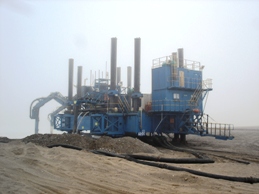
The coastal strip, extending northwards from the Orange River mouth to >1000km north, contains diamonds that generally decrease in grain-size to the north. Another trail of diamonds, also decreasing in size to the north, is found along the South African coast - beginning roughly at the mouth of the Oliphants River and ending roughly at (or South of) the Orange River mouth - a distance of c. 350 km.
It is difficult to escape the conclusion that there are two dispersal systems along this coast: the Orange River, and probably the Oliphants River or its precursor. The Oliphants River would have been a far earlier drainage than the Orange, and would have built a diamond deposit that was subjected to a range of sea-level changes far greater than those of the Orange River coastal deposits. Deposits from the Oliphants River are probably recorded in the offshore seismic sections at c.119 Ma.
In post Cretaceous time the inner shelf from the Cape of Good Hope to the St. Francis Bay in the north was neutrally buoyant. There is very little post-Cretaceous sediment on this part of the shelf and it would appear that the Orange River sediment was effectively dispersed according to grain size, with the coarse sediments (from the Pan-African and associated formations) being plastered along the coast. Sand moved then along the coast by longshore drift and was then blown back onshore to form the Namib Sand Sea while the more fine-grained sediment was transported along the coast and out eastward, to build the continental shelf edge (Fig. 3b ). In this sense the Orange displays a peculiar kind of delta, with the sand fraction returning to land and the mud being almost entirely removed.
A number of factors are needed to achieve this kind of sediment dispersal. First, it requires a shelf that does not subside greatly, to allow the build-up of sediment. Second, it requires a very high-energy system along the coast, capable of separating the sediment and transporting it away from the point of original discharge. Wave-heights in the region average c. 1.75m (winter) and 1.5m (summer) and have a particularly long wavelength. This means they are able to scour the shelf to some depth. Third, it requires an arid or semi-arid coastline that may have existed for as long as c.50 Ma.
Many of the diamonds move with the gravel and are separated further when they meet the wave-cut platform. These platforms, repeatedly cut by the fluctuating sea-level, are often extremely rough and it is this roughness that allows populations of diamonds to form within them. A very high percentage of the coastal diamonds are therefore trapped in the rough bedrock, but the overlying beaches also trap diamonds. Platform roughness varies along the coast according to the nature of the bedrock. Beach characteristics also vary along the coast from south to north - spits in the south decrease to the north, where they are replaced by barrier and linear beaches, and finally by pocket beaches. These beaches, which are Pliocene to Recent in age, were very clearly laid down some 20-40 Ma after the main flux of diamonds came down the river. They acquired their diamonds not directly from the Orange but from the reworking of former deposits in the offshore.
While land extraction of diamonds is almost complete, both inshore and offshore clearly have enormous potential.
The conditions that successfully separated the grain sizes of the Orange River sediment and concentrated the diamonds are also providing workers inshore with great difficulties in their recovery work. Wave energy on that coast is so high that although it separates the diamonds from the sand it also provides the diggers with enormous practical obstacles. Diving has proved too hazardous and the miners are now working a on a legged platform that 'walks' out to sea sucking up the sediment. Small scale trials using this method have had moderate success.